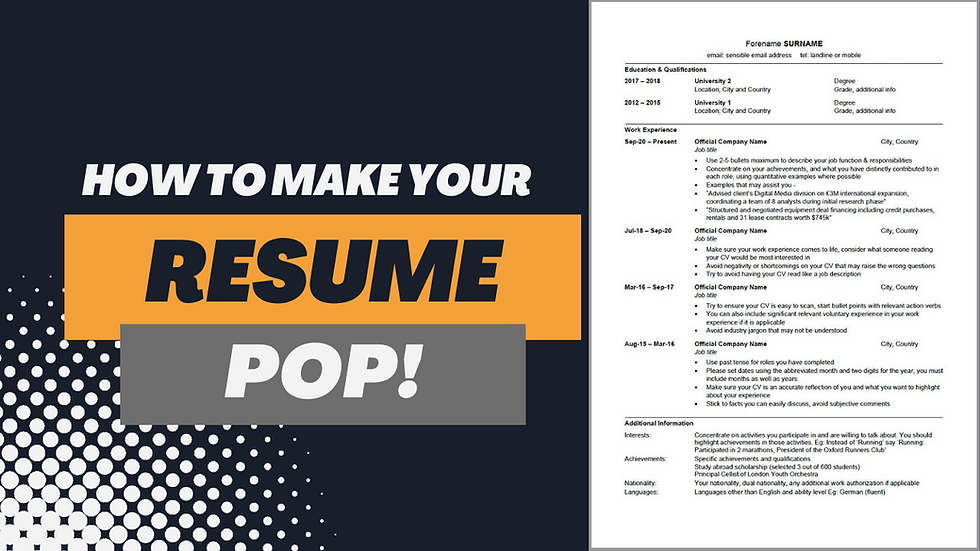Adapt Your Work Resume For MBA Applications
Updated: Feb 12, 2024
Did you submit your regular work resume to business school?
If you got dinged, this could be a factor.
The resume that got you hired at a consultancy firm or investment bank or industry role will not get you into a top business school.

What sets an MBA resume apart
Your MBA resume and your professional resume have different goals altogether, so they should be different.
In a professional resume, your goal is to show hiring managers that you have the knowledge, domain expertise, and technical qualifications to fulfil the role.
However, in your business school resume, you need to highlight the business impact you have created, your ability to collaborate with others, and your motivation to solve real-world problems as a future leader. Your goal is to demonstrate what top business schools care about the most - leadership.
In your one-page MBA admissions resume, the Work Experience section can take up to 2/3rds of your canvas. This is business school, after all. Thus, it is crucial to create a compelling picture of your career history, progression, and leadership potential through this section.

How to Write About Work Experience in the MBA Resume
Work down the page in reverse-chronological order, beginning with your current role. Separate entries by title and duration of each position held (even if it’s at the same organization). Optionally, include a 1-line description about the organization under each entry. This is particularly the case if you worked at relatively unknown brands.
Yes, it’s all bullet points in a strict format, but there’s a story to tell about your career here. Your professional trajectory should show upwards progress. For example, if you began in a junior position at your company, your emphasis as you write about your next role should be on how you took on more responsibility.
Be bold and loud about your impact in every role.
All the way from entry-level positions → bigger-picture, leadership experiences.
Use these action points to make your MBA resume pop:
Step 1: Start with a Master Business School Resume document, so you don’t have to reformat yourself. Write comprehensive bullet points for each role, highlighting your accomplishments and quantifying them wherever possible. Focus on your impact on the organization - times when you took initiative, went beyond the call of duty, or rescued a sinking ship.
Step 2: Reflect on the variety of skills you have acquired over the course of your career. Under each role, highlight the new skills you gained as you progressed in the same or at a different organization, especially through on-site training. The most relevant skills for top business schools are leadership, communication, collaboration, problem-solving, innovation, entrepreneurial spirit, resilience, and critical thinking.

Step 3: Re-examine your bullet points for repetitiveness. For example, an MBA applicant who has worked in multiple sales-oriented roles does not have to repeat that they performed client research under each experience. Highlighting this once is enough. This also frees up space to explore other skill-building areas in your role.
Step 4: Don't overdo the technical jargon. The AdCom member reading your resume may not have worked in your industry, but they should be able to understand your role and responsibilities without having to Google them. Challenge yourself to use understandable language, especially if you have a technical background.
How to Structure Your Work Experience Bullet Points
Use the A-C-E structure to write your bullet points. This structure will enable you to show leadership and impact within each entry.

Action: Start each pointer with an action verb in the past tense. This verb should clearly capture the nature of your task. Some good words that suggest impact are led, spearheaded, analysed, launched, collaborated, innovated, budgeted, implemented, and strategized.
Context: Add the context of your work so that an outsider can clearly understand the significance of your work and the impact you’ve made to the organization. For example, instead of saying “Managed a team of 6”, explain your goal in detail. “Managed a team of 6 to brainstorm the marketing strategy for the launch of a brand’s new product line”.
End result: Once this context/goal is established, you can get to the most crucial bit: quantifying your impact. Use data to your advantage by including currencies and percentages. Not every achievement is quantifiable, but most should be backed by data.
How to Format Your MBA Work Experience
A simple, consistent format is easy to scan and light on the eyes. Here are three key aspects to consider for good business school resume formatting:
Font size: 10/10.5/11 for the text. Section headers can be 1 point larger, if needed. Your name can be slightly larger, either 12/14/16, depending on personal preference or university requirements.
Font style: Calibri and Arial are the most commonly used fonts. Many MBA candidates also use Times New Roman for their business school resumes.
Spacing: Your resume must be evenly spaced so that the reader isn’t confronted with an overwhelming block of text. Use a 6-point font for the spaces and at least 1 cm margins on all four sides.
Note that some business schools, such as Oxford, INSEAD, and Cambridge issue their own resume formats. You can also consult their suggested alumni templates. If you’re struggling to get the ball rolling, check out our free Resume Builder with easily downloadable resume word templates on MBAConsultant.com.





















_JPG.jpg)







.png)



When writing about work experience in your MBA resume, focus on quantifiable achievements, relevant skills, and leadership roles. Highlight specific projects, the impact of your work, and any initiatives that align with your MBA goals. Be concise yet impactful, showcasing how your experience makes you a valuable candidate. If you need help with presenting complex data, consider using online statistics assignment help to ensure your work experience is presented accurately. Tailor each job description to reflect the skills and qualities that MBA programs value most.